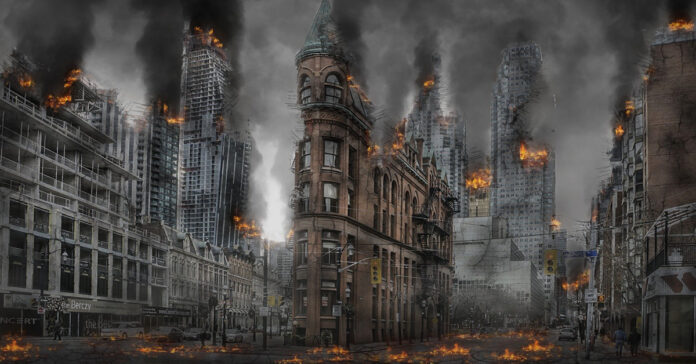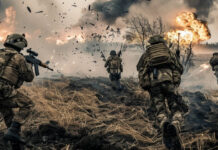I’ve talked about how an EMP, nuclear war, comet strike, solar flare, or other large-scale global event that eliminates our ability to produce and distribute electricity and other utilities could send us all back the point where we are living life similar to people in the 1880s. This post digs deeper into that topic and what this worst-case scenario means to you as a prepper.
Government estimates are that up to 90 percent of the population would die off in the event of an EMP that affects the entire country. Many of these deaths would be from starvation, temperature extremes, a lack of prescription medicine and medical equipment/treatment, drinking dirty and contaminated water, and a rash of diseases caused by a lack of hygiene and sanitation. Battles over what limited resources remain will result in many more deaths. Maybe some military bases and other pockets would survive, but most of the country (or the world) would be on its own and it would literally be dog-eat-dog. Some people will survive, either through luck or planning. Ideally, the prepper will benefit from both.
Let’s assume it takes two years for the die-off and unrest caused by the collapse to fully manifest, peak, and then decline. After two years, there is no more stuff to fight over and few left to fight.
Let’s further assume that it takes an additional two years for things to settle down and people who survive the first phase begin to feel safe and comfortable in their new life. Only when we have stability will rebuilding begin.
The Village Structure
Since medieval times, the village was the primary self-sustaining structure in which people formed communities, lived, traded, and built their lives. Villages allowed a few specialists to gather and provided the populace to support them. For example, you didn’t have to learn to shoe your own horse if you could go to the village blacksmith. You didn’t have to grind your own grain by hand because you could go to the miller. You could go to the village church. There was probably a sheriff to ensure basic laws were obeyed. When danger threatened, the village pulled together to face it, along with the men at arms of the local knight or lord.
Even today, in less developed countries, the village often remains the primary trading point and meeting place for people from the surrounding areas. It’s where local farmers go to sell their harvests, where the populace goes to buy cloth or clothing, and where imported goods can be obtained.
I expect we might see the re-emergence of a village structure post collapse. It might start with someone with a well-armed crew of people running a marketplace or swap meet once a month and develop from there. Over time, the swap meet could become a weekly marketplace. The concentration of people coming to the market could attract entertainers, or a traveling preacher who sets up a tent and preaches a message of hope and salvation. Merchants from out of town might come with wagon loads to sell. Salvagers who recover goods from abandoned cities would show up with wagon loads of goods. Eventually, someone sets up a restaurant and an inn for travelers. Then other basic services might pop up, like a school or a medical clinic. Before long, a village will have formed.
Rebuilding our Technology Base
Only once we have a stable village society and no one is worried about where their next meal is coming from will people have the leisure to spend time on rebuilding electrical generation, large-scale coal mining, and refining petroleum products. I expect that will take years, but pockets of a more advanced civilization (say we reach the level of the 1920s instead of the 1880s) will pop up at multiple locations across the country.
While early cities in the U.S. formed at convenient ports, junctions of rivers, railroad tracks, and other points that supported commerce and transportation, I expect new towns will form at places near sources of hydroelectric power, oil refining, and the production of food stuffs. The large cities like New York, Los Angeles, Chicago, Atlanta, Boston, Houston, Miami and so forth will be abandoned after the collapse because it will be very difficult to survive in those environments without utilities and services.
These old cities will become sources of coper wire and pipe, steel, and other building supplies as salvagers tear them out of abandoned structures. This will give the recovery a head start as the recovering society won’t have to mine iron ore, copper or other metals for some time, just coal to melt the salvaged metals and to heat homes and generate electricity.
The Population
If 90 percent of the population dies off, that would leave us with 30 to 35 million people in the U.S., less than the 50 million who lived in the U.S. in 1880. Potentially, there will be plenty of goods to salvage for a few decades, assuming that large sections of the country are not off limits because of excessive radiation.
Most of the pre-collapse food will be gone, but think of all the abandoned cars that can yield metal for new uses. Think of the wheels and tires that can equip horse-drawn wagons, meaning no wooden-spoked metal-shod wheels like those that existed in the 1800s. There may be sufficient amounts of clothing in abandoned closets and dressers or un-looted stores to clothe this much smaller population for years. Salvagers will bring back more than iron and copper; they will bring back furniture, apparel, textiles, jewelry, art, books and kitchen accessories. Things like cleansers and shampoo will have little use or value in the first weeks after a collapse, but will probably bring a good penny five or six years down the road.
This will make the recovery easier because we can focus on electrical generation and distribution, not providing basic goods like cookware and blankets. Salvaging will make recovering easier than building from scratch. Likewise, society won’t have to invent things like casing iron or manufacturing plastic, just find someone who has the education, experience, and skill to lead the effort.
New Jobs vs Old Jobs
Many of the jobs people have today would cease to exist without access to technology. Skill with computers or electronics will be useless. Likewise, anyone who drives or pilots a vehicle will be out of a job as soon as we run out of fuel. In the 1880s, local transportation meant walking, riding a horse or mule, or riding upon a horse-drawn conveyance. Instead of 18-wheelers, they had wagons drawn by oxen. Post-collapse, that is all we will have access to for some time until we can produce petroleum products and getting some kind of oil distribution system set up.
Unfortunately, we have nowhere near enough horses or oxen to fulfill our post-collapse needs, but that creates an opportunity. Horse and other livestock breeders will be in high demand, as will tanners and leather workers. We won’t just need people to raise cows or pigs for beef, but for leather. Then we need tanners and people to sew saddles, halters, reins, and other leather goods. Tanning was once a large-scale business in the U.S., and it may become so again during a recovery.
In addition to horse-drawn carriages and wagons, there were trains in the 1800s, most powered by steam engines that burned wood or coal to generate steam. Steamboats also transited the Mississippi and other major rivers. While a trains or boats transported some food, much was produced locally, a paradigm we will see re-exert itself. The train tracks would exist after a collapse, but working steam engines will be rare. It will take some time before trains became a primary method of transportation. When they do, it will connect vast sections of the country and the economy and the recovery should speed up.
Other Changes
While Thomas Edison developed the first viable lightbulb in 1879, there was no electrical grid. Most homes were lit by candles and oil lights for the next few decades, longer in rural areas, while major cities enjoyed gas-powered street lights. After a collapse, much of the electrical transmission lines will remain, but generation is a problem. If an EMP caused the crash, there may be few working transformers. It could take a decade or more to rebuild, assuming someone somewhere has the capability, technology, raw materials and willingness to build transformers, or the wherewithal to develop that technology from scratch. Even then, imagine how long it will take? I expect local electrical grids will be up well before anyone is willing to link them into regional grids.
Today we text messages in a mere second, often dictating to our phone. Without electricity or the Internet, we will be back to communication by letter, except for a few HAM radio operators whose equipment survives the fall.
Perhaps we can rebuild the telegraph system or the old fashioned wired telephone (POTS) system. We’d probably be back to human operators who transfer calls and initial systems would be good for local calls but lack long distance capabilities. Still, after eight or ten years of no electronic communication, the ability to call a neighbor or the fire department would seem like a big step.
What This Means to Preppers
If the scenario outlined above comes to pass, preppers would need to do the following to make it until the recovery:
Survive the immediate aftermath, the killing, the rampaging, the unrest, the violence, the sudden lack of utilities and total evaporation of the supply chain. You would have to be able to defend yourself, heat your abode, provide clean water and sufficient food for everyone in your family or party for at least the first two years.
Then, you would have to support yourself for several more years without little or no outside support. This means you would need to be self-sufficient and raise, grow, produce, find, catch or kill your own food. You would have to be able to maintain a level of hygiene and cleanliness to prevent illness and to minimize infection. You must also have a way to dispose of waste, both human wastes and solid waste, which would normally go to a municipal dump. If there are diseases or illnesses, you would need to treat them, and address toothaches and other dental emergencies. Birth control will run out, meaning your group may have to deal with pregnancies and raising babies in an era where there is no formula or disposable diapers.
If you have livestock, you must be able to feed them, care for them, protect them and keep your fences up without going to the general store. If you feed hay during the winter, you must figure out how to source hay once the tractor stops running. Likewise, if you burn firewood, a time will come when you will have to harvest it without power tools.
Next Steps
Thought out this period, the group must be able to defend itself, possibly joining with neighbors to form an advanced neighborhood watch/mutual support group. Every minute you spend protecting the retreat will be time that you cannot spent planting food, cutting firewood, or providing for the future, but it is critical nonetheless
At the same time you are working like it is 1880, you must make an effort to retain and pass along the knowledge that society cannot afford to lose. We don’t want to sink back further than the 1880s. We want people who know penicillin exists and can one day produce it again. Likewise, we want people who can understand geometry and build square houses and straight buildings without having to re-invent the math or the technology. Once petroleum comes back on stream, you will need to remember how to fix an internal combustion engine. Eventually, we’ll need people that know-how to design a wing that creates lift for airplane and boats that can hydroplane across the water, things people had to figure out themselves the first time around.
Hopefully, we will have learned our lessons. We’ll rebuild the government like it was envisioned by the founders, not the politicians. This kind of collapse will indeed be a great reset, but none the kind foreseen by the World Economic Forum or the Global Elites. Resetting our technology back 140 years and losing the distraction of the modern world could help the country regain its moral compass and get back to life like we lived it before the New Deal set the stage for a long decay.
Collapsitarians
There are some who think we need this kind of collapse, that we cannot continue to move forward but must first fall apart so that we can rebuild from scratch. I am not hoping for or promoting a globe-spanning war or other disaster, but I can see their point. I think we are in a slow collapse that cannot be seen up close but must be viewed by future historians. If this slow collapse should turn into an overnight disaster, a SHTF situation that leads to the above scenario, I hope to survive it, aid in the eventual recover, and help ensure people learn their lesson and do not repeat the mistakes of our past.







